Lecture VI
Dutch and Flemish Painting
Meister Bertram,
Hieronymus Bosch,
Dieric Bouts,
Pieter Brueghel,
Petrus Christus,
Gerard David,
Jan Van Eyck,
Master of Flémalle,
Geertgen tot Sint Jans,
Hugo van der Goes,
Quentin Matsys,
Hans Memling, and
Joachim Patinir.
Dornach, 13th December 1916
The pictures we shall show
today are to illustrate the development of Dutch and Flemish painting
towards the end of the 15th century and on into the 16th.
From the inner historical
point of view, this is one of the most important moments in the evolution
of Art. It is, as you know, the period immediately after the dawn of the
fifth post-Atlantean epoch — that epoch which is called upon to
bring forth, out of the depths of human evolution, all that is connected
with the development of the Spiritual Soul. In the Dutch and Flemish
pictures we shall now consider, this comes to expression in a most
characteristic way. We see in every detail how the Spiritual Soul begins
to work. We can see it, my dear friends, if only we bring to these works
of Art an elementary power of understanding — that is to say, if we
have to some extent escaped the unhappy fate of being historians of Art
after the modern fashion.
The most up-to-date of the
modern critics and historians will, no doubt, consider a critic like
Hermann Grimm an altogether inferior intellect. But if we have not the
misfortune to be quite so up-to-date, then, even if we knew nothing
beforehand of the laws and impulses of human evolution as explained by
Spiritual Science, we should still find in this artistic evolution a
wonderful confirmation of all the differences which Spiritual Science
indicates in its descriptions of the Third, Fourth, and fifth
post-Atlantean epochs. It is interesting to see how gradually there
emerges — century after century during these epochs — what
we may regard as the fundamental frame-work of the artistic conceptions
of today. It is interesting to see the several elements of it emerging
in the most manifold quarters in the evolution of mankind.
If we go back to the history
of drawing and painting, we find that the laws of Space, for example, have
only been evolved by gigantic efforts of the human soul. The older
representations in line and color do not really constitute a pictorial Art
in the modern sense. They are more like a kind of narrative or
story-telling on the flat surface. This applies to a by no means very
distant past. (Without entering at length into these historic aspects, I
will only indicate a few general points of view.)
We can see that in those
olden times, the artist had in his mind's eye some story which he wished
to portray — a story such as one might even narrate in words.
He did not try to represent Space as it is; he simply fixed on to the
flat surface what he desired to represent. The various things that he
relates stand side by side on this flat surface. From our point of view,
we could, at most, regard this as a kind of primitive illustration.
Today we should not even allow the art of illustration to proceed in
this way, merely setting down the events of the narrative on a flat
surface.
At the next stage, an
attempt is made to represent the ordering of things in Space, at any rate,
in a most rudimentary way, by introducing the principle of overlapping.
The artist makes use of the visibility, or partial visibility of this
or that figure.
A figure that stands in
the way of another, is in the foreground; the other stands behind it.
By this method of overlapping, the surface is really used to suggest,
at any rate, the dimension of depth.
At a following stage, the
several figures are already made larger or smaller in proportion, taking
into account that that which appears larger is to the front, while all
that which appears smaller is further back. If, however, we return to
the Third Post-Atlantean period, we find that this spatial treatment
to which we are now accustomed, did not exist at all. They either put
things down on the flat surface, as described above, or else they used
the element of Space to express their thought. This, indeed,
continued into the Graeco-Latin period. Contrary to the way in which
things are really seen, we often find figures which are obviously to
the front (nearer to the spectator) smaller in proportion to other figures
which are further away. In olden times they often made use of this kind
of treatment.
We see a King, for example,
enthroned in the background of the picture. His subjects, in the
foreground, are represented as being smaller in proportion. In Space they
are not really smaller, but according to the conception prevailing, they
are smaller in idea. Hence, while they are placed in the
foreground, they are made smaller. This gives you the transition to a
thing you will frequently find in older times — I mean what we may
call "inverse perspective" compared to the perspective we know
today. In this “inverse perspective” we must imagine things
envisaged as they are seen by a particular figure in the picture. Figures
which are in front from our point of view can, indeed, be smaller than
other figures which are farther back, if a figure in the background
is conceived as the observer of the scene. But to this end the man who
is actually looking at the picture must entirely obliterate himself!
He must either imagine himself away, or he must think himself into
the picture, as it were, — into the personality of the figure
conceived as the observer of the scene.
Here, then, we have an
Impersonal perspective. This “impersonal perspective”
was still suited to the stage of the Fourth Post-Atlantean epoch, when
the Spiritual Soul was not yet so consciously born as afterwards. The
man of the fifth Post-Atlantean epoch cannot forget himself; he demands
a presentation arising from his own point of view. Hence it is that the
art of perspective, strictly related to the visual point of the spectator,
only appears with Brunellesco — that is to say, is the main, with
the beginning of the Renaissance.
We may truly say that what
is now called perspective was first introduced into the technique of Art
at that point of time. Moreover, the South, through the impulses I
characterised in one of the earlier lectures, is the inventor of
perspective. For the South is much concerned with the ordering of things
in the inner relationship of Space; concerned, that is to say, with
qualities in extension. Thus the South is predisposed for mastery in the
whole art of composition, and at a later date we see this art of
composition fertilised by the Southern Renaissance — with all that
I have described already as the inherent impulses which then came to the
surface, and reached so high a degree of perfection.
Thus there comes forth
in Art what we may call the gathering together of things in Space, where
the man who looks at the picture is included in the whole conception.
Truly, this corresponds to the age when the Spiritual Soul is born —
when man becomes conscious of himself.
Hence it is in the south
— in all that is connected with the Southern culture, which we
have described before — it is here that the modern principle of
perspective first arises. We see how it evolves quite naturally out
of the Southern culture.
Meanwhile, however, another
principle is at work, is emerging in the North; this principle we see
in its nascent state, as it were, in the very moment of its origin,
when we turn our gaze to the Brothers Van Eyck.
In the two Van Eycks —
Hubert van Eyck to begin with, and later in his brother Jan —
we see emerging, albeit in a different form as yet, what afterwards came
forth as described when dealing with Rembrandt, for example. Something
which emerges out of the Mid-European, Northern element. These things
always find expression in external symptoms — in outwardly real
symbols, if I may so call them. Brunellesco must be conceived as the
inventor of modern perspective. The ancient perspective — that which
underlies the Greek pictures, for example, — does not possess what
is called a “vanishing point.” It has a whole “vanishing
line.” The scene we see seems to converge, not in a vanishing
point, but in a vanishing line. In this is, indeed, expressed the radical
difference between the ancient perspective and the modern, which is
the perspective of the fifth post-Atlantean epoch.
Brunellesco, then, is
the discoverer of modern perspective. It is discovered in the South.
Whereas in the North — this is no mere tradition, but contains
a profound truth — in the North oil-painting is discovered.
Although Hubert van Eyck was not the sole inventor of oil-painting,
nevertheless, it is true that oil-painting was discovered in the age
and out of the whole milieu out of which he created.
Now what does this signify?
What is the underlying reason? For the art of oil-painting was then
carried to the South. Perspective was carried from the South to the North;
oil-painting from the North to the South. What does this signify?
It is deeply rooted in
their fundamental character and mood of soul. In the South men have
a feeling for coming together mutually in the Group. The South has far
more attachment to the Group-soul as such. Hence the people of the South
are fond of describing themselves as members of such and such a Group.
They have little understanding of the individual principle. Such things
should be taken into account, for Nations will never understand each
other if they take no pains to grasp their several characteristics.
When a man has been brought
up in the more Latin spirit — who has received the inner impulse
of the Southern nature — speaks of his devotion to nation or people
— when he calls himself a Patriot in one sense or another, he means
something very different from the Mid-European who speaks of Patriotism.
Mid-Europe really has no talent for this belonging together, this
gathering of men together into a Group. In Mid-Europe there is a faculty
for the Individual principle. The true native character of Middle Europe
is expressed in the recognition of the Individual, and in the age of the
development of the Spiritual Soul this implies, to begin with, the
recognition of the personality, the human individual —
the person.
Now, if we feel essentially
the Group-element, which is, of course, extensive (spread out in space),
we shall naturally live in the element of composition. One who has
this tendency will have a natural understanding for the art of
composition. If, on the other hand, we have a strong feeling for the
individual principle, we shall seek to mould the individual from within
— outward. Instead of seeing the Spirit, as it were, put forth
its feelers to embrace and hold the Group together, we see the Spirit
within each single form; we place the several individual figures side
by side, seeing the Spirit in each single one. We seek to bring to the
surface of the body what is there in the inner being of the soul.
This is not to be achieved
by perspective, but by color that is irradiated, flooded by
light. Thus in the profoundly Germanic brothers, Van Eyck, we have the
real starting point of the modern art of color, which seeks to hold
fast in the color itself, what comes from the individual character of
the soul to the outer surface of the body.
The brothers Van Eyck
and their successors, derive their essential inner quality from this
Northern Mid-European element, while composition, which gradually finds
its way into their works, is borrowed more from France and Burgundy.
It is no mere matter of
chance that this special development in the 15th century took place
at a time when the districts where these artists lived did not possess
a hard-and-fast political structure. Such a structure was only afterwards
imposed upon them from the South — from France and especially from
Spain. In that period we see spread out over the Northern and Southern
Netherlands the more individual City-formations — towns and cities
whose connection as compact States was at most a very loose one. The
people of those regions, and of that time, had no inclination to think
that men ought to be held together in groups by well-defined States,
where the State itself is the important thing — where the precise
extent and frontiers of a particular State are considered a matter of
importance. To the people out of whom the brothers Van Eyck arose, the
particular nation to which they belonged was not the point. Nor did they
think of what is called the “State,” or trouble themselves
about its frontiers. What mattered to them was that human beings full,
thorough-going human beings — should develop, regardless of the
group to which they might belong.
So we see this Art of the
Southern Netherlands, the regions of Flanders. The inner being of man is
conjured forth to the surface of the body in a tender and thoughtful way.
By a mysterious power they flood their pictures with light, introducing
just that element which color can introduce, for the individual
characterisation of the soul.
Then we see the burgher,
the citizen virtues of the Northern Netherlands reaching down into the
Southern aristocratic element. The life of the burghers gives birth
to that Art which places the individual so thoroughly into the world.
It is, in reality, an overcoming of the Group-soul principles in Art.
And yet, as we shall see
in the very first of our pictures today, how wonderfully the mass-effects
are, nevertheless, attained. But with these mass-effects, it is not that
they are conceived as a group from the outset. They arc not deliberately
constructed: the figures distributed in Space so as to belong together
as a Group. On the contrary, these wonderful groupings arise through
the very fact that each individual being has his full importance, and
takes his stand beside the others.
Such are the things that
we shall recognise out of this portion of artistic evolution. In the
brothers Van Eyck we still have comparatively primitive, rudimentary
groupings in Space, but withal a high degree of inwardness, and a strong
adaptation to what is actually seen, regardless of any hard and fast
conventions.
In effect, we have here
the second pole of that entry into the physical reality in the artistic
life, which belongs to the fifth post-Atlantean period. This pole is in
the North, while the other takes its start from the Italian art of the
Renaissance. There we have the element of composition, and all else is to
some extent subservient to this. In the North we have a creating from
within, outwards. Only gradually and by dint of constant striving do they
arrive at a certain power of composition by the placing together of
individuals portrayed with inwardness of soul. Thus the one aspect of the
naturalistic principle in Art, which belongs to the fifth post-Atlantean
epoch, found its essential fountain-head in these regions. These painters
place their subject in the immediate reality which surrounds them. The
Biblical story, for example, when reproduced in Art by men of earlier
times, was taken right away from their immediate surroundings. But this
period in Art places the Biblical narratives into the midst of the
immediate naturalistic reality. Men of the Netherlands stand before us as
the characters of Biblical history.
What formerly shut one
off, as it were, from the outer naturalistic world — the golden
background and all that was expressed in it — ceases to exist.
On the very soil where we ourselves are standing, the Biblical scenes
move before us.
It goes with this, quite
naturally and inevitably, that they everywhere surround their human
figures with that peculiar treatment of space which we find in their
interiors, not in their outer landscapes. I would express it thus. Having
ceased to be living in the composition, the space itself must be
transposed, transplanted into the picture. Space, as such, must now appear
in the picture. How, then, can this be done? By shaping a portion of the
picture itself as a “space,” that is to say, by placing the
figures in an “interior” — in a room, or the like. Or,
again, by painting a naturalistic space such as forms itself around the
human being in the landscape. Thus with all the impulses of the new age
which, as above described, permeate especially this Dutch and Flemish Art,
we see arising quite naturally, the art of landscape painting. The
landscape appears, often with a mighty and overpowering grandeur, in the
background of the figures, or in some other way.
This Art evolves and
flourishes most beautifully in the age of the free cities, when every town
or city in these regions has a pride in its independence, and feels no
inner need for territorial union with other cities. A certain
international consciousness arises. This freedom from separations, this
freedom from the Group-spirit, is a product of the sound and strong
Germanic burgher-spirit of those times and places.
All this grows out of the
life of the Northern and Southern Netherlands. Influenced very slightly
by the South — influenced only by the Southern art of composition
through the adjoining southern countries — their artistic creation
springs from this democratic strength and soundness of the burghers,
and blossoms forth until the time when the whole thing is eclipsed,
if I may put it so, by the Group-mind once more.
Thus the period in artistic
evolution which we shall illustrate today is at the same time a period
of free development of human beings. I might continue to say many other
things; but I wanted, above all, to fix your minds on the world-historic
moment when this development in Art took place.
We will now proceed at once
to show a number of pictures on the screen.
We begin with the famous
Altar-piece of Ghent, by the Brothers Van Eyck.

1. The Brothers Van Eyck. Altar-piece. (St. Bavo. Ghent.)

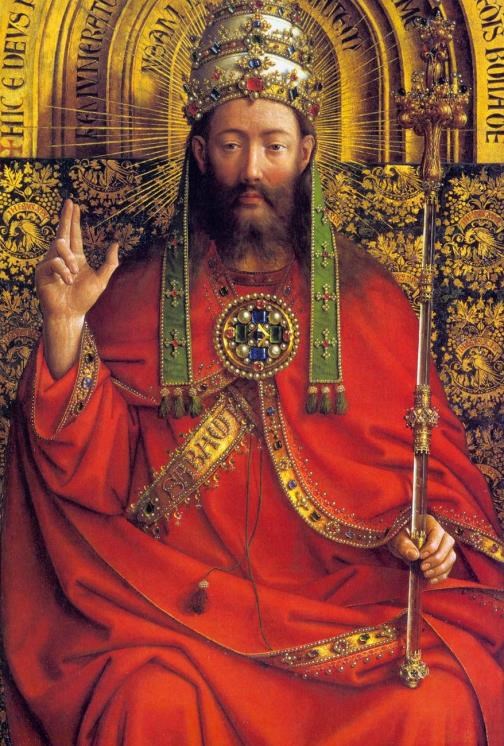
2. God, the Father


3. Mary
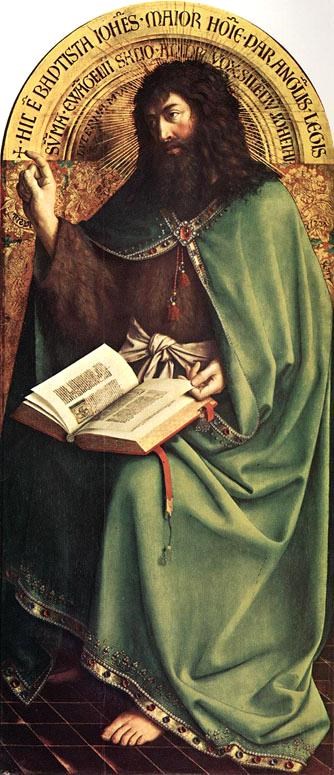
4. John
This Altar-piece consists
of many parts. This is the portion seen when the front is opened —
the middle portion above the Altar. The figure in the center, in Papal
costume, is representing God the Father. Conceived in the spirit of the
Church, God the Father is actually represented as a Pope. Nevertheless,
the features I have indicated are recognisable in the whole artistic
composition. If we went back still further, we should find the preceding
evolution altogether steeped in Christian ideas — the Christian
traditions — that is to say, which the ecclesiastics forcibly
impressed upon the people. These traditions most certainly corresponded
to a manner of thought inspired by the Group-consciousness. But out
of the midst of this very element we now witness the individual spirit
making itself felt.
The figure to your left
is Mary; that on the right is St. John. Here, then, we find ourselves
in the first third of the 15th century. Hubert Van Eyck died in 1426;
the Altar-piece was finished by his brother Jan. It is the first third
of the 15th century.
From the same Altar-piece
we will show the angel-pictures, to the right and left of these central
figures.

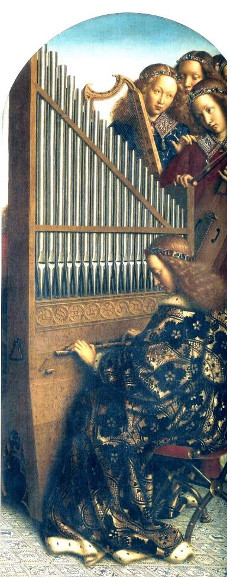
5. Angels making Music
Here you see a group of
angels playing on instruments of music. Compare them with the angels
by the German Christian Masters of the period immediately preceding
this. Lochner, for instance, or the Master of Cologne — the pictures
we saw in a former lecture. You will see how great a difference there is.
The angels here are full-grown human beings, in spite of their clerical
and ceremonial garments — fully developed human beings —
no longer as before, half child-like forms. In such a group as this, you
will see that the artist has not yet reached a thorough-going perspective.
The perspective is only carried through to a slight extent. You see the
whole picture on the surface — spread out like a tapestry. We will
now show the angel-picture from the other side of the altar-piece.

6. Angels singing
This whole Altar-piece
was done by order of a wealthy Burgher for the Church of St. Bavo. The
several parts are now scattered abroad — at Ghent, in Brussels,
in Berlin ...

7. The Brothers van Eyck. Adoration of the Lamb.
Here we come to the main
portion of the picture, beneath the other three. The “Adoration
of the Lamb” is one of the fundamental motifs of this and the
preceding period. Here we see it beautifully presented as the fundamental
religious conception which had evolved during the course of many
centuries. It could not have been embodied in this beautiful artistic
form till they had so grown together with this conception as to represent
it thus. Throughout the centuries of Christianity this idea had gradually
taken shape — this idea of the Salvation, the Redemption of mankind
through a great Sacrifice.
We must go far, far back
in time to realise its full significance. Compare the subject —
the story which this picture tells — with a picture, for example,
of the Mithras Offering. There you have Mithras seated on the Bull;
the Bull is wounded, the blood is flowing. It is the uplifting of Mithras,
His salvation by the overcoming of the Beast. You are familiar with
the deeper spiritual meaning of this picture; it is, if I may so describe
it, the very antithesis of the one we now see before us. The rearing
and rebellious Bull has to be fought down — gives up his blood
by force; the Lamb gives His Blood of His own free will.


8. Adoration of the Lamb as compared to a Mithras-Relief
What does this signify?
Salvation is lifted out of the element in which it was previously
conceived — the element of violence, and strife and conflict. It
comes into the element of free devotion and out-pouring Grace. Such is
the idea which is here expressed. Not by man seeking in pride to rise
beyond himself, seeking to kill his lower nature, but by experiencing
in his soul that which streams through the world and patiently suffers
with the world, will he attain his liberation at every point of this
world's existence, his redemption.
Such is the Universal —
and therefore, the individually universal — principle of redemption
which we here find expressed. The Lamb is One, yet no one being is striking
it. Therefore we see it offered up for every one of those who worship
it, who draw near to it from all their different spheres of life —
near to the Lamb of Salvation, near to the Fountain of Life.
The greatest conception
of the Middle Ages, grown and matured in the course of the centuries,
is thus recorded at the end of the Mediaeval Ages by the brothers Van
Eyck, and there arises in this period one of the greatest of all works
of Art.
Of course, we must bear
in mind the points of view I emphasised just now. The individual principle,
creating from out of the inner life, wrestles still with an inadequate
mastery of the treatment of space. You will, for instance, scarcely
be able to imagine a spectator situated with his eye in such a place
as to perceive the spatial distribution of this figure here (at the
bottom of the picture).
Very beautifully Van Eyck
portrayed how the Impulse of the Lamb works in the various callings,
in the several branches of human life. Here are some examples.
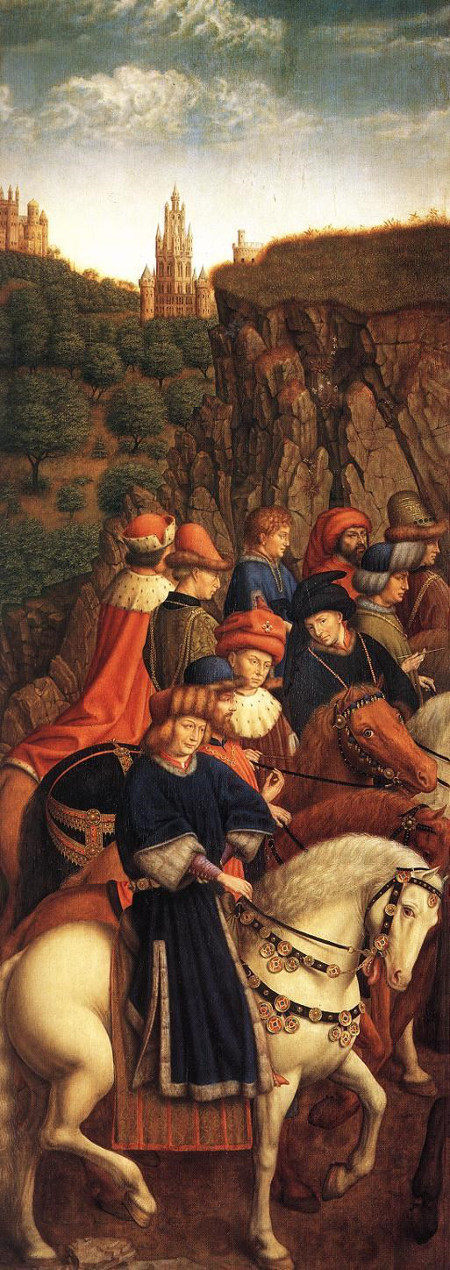
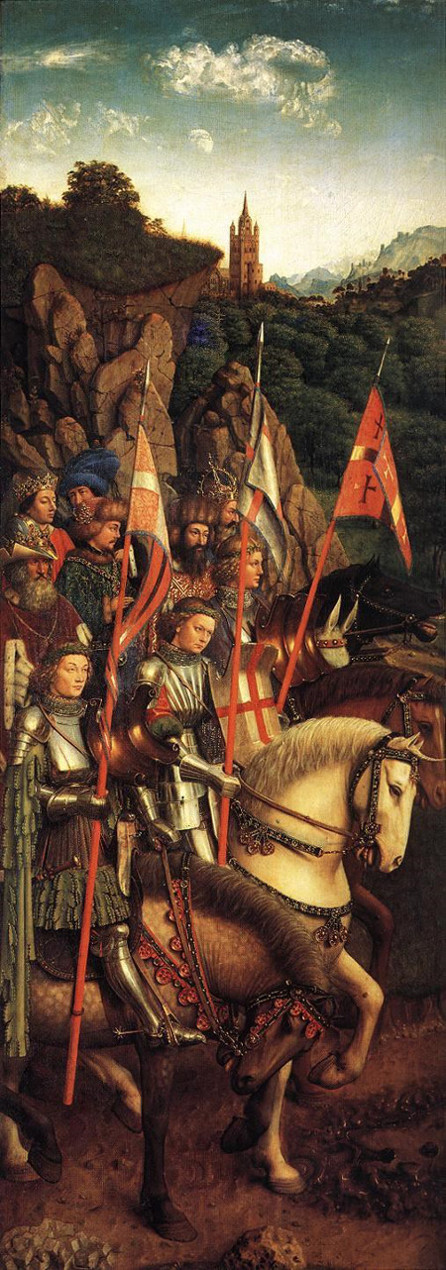
9. Brothers van Eyck. The Knights and Judges. (From
the Altar-piece at Ghent. Berlin Museum.)
These are the Judges and
the Knights as they draw near to the Lamb. All these are portions of
the same great Altar-piece. The next is a very tender picture:
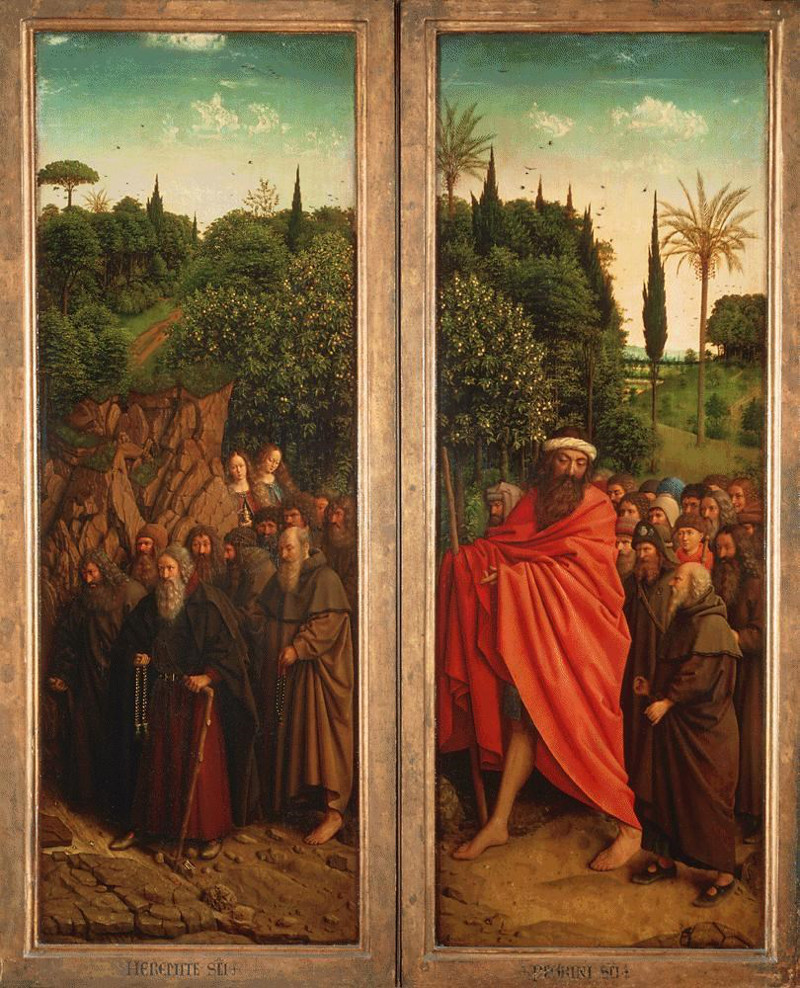
10. Brothers van Eyck. The Pilgrims and Hermits. (From
the Altar-piece at Ghent.)
Here we can already admire
the treatment of landscape in relation to the human beings to whom it
belongs.
Hubert van Eyck died in
1426, when the Altar-piece was not nearly finished. His brother Jan
continued working at it for many years, and scholars have long been
engaged in the dispute, which they seem to regard as so important, as
to which portions are due to Hubert and which to Jan. This dispute is,
after all, more or less superfluous, if we are interested in the artistic
aspect. We now come to another picture by Van Eyck.
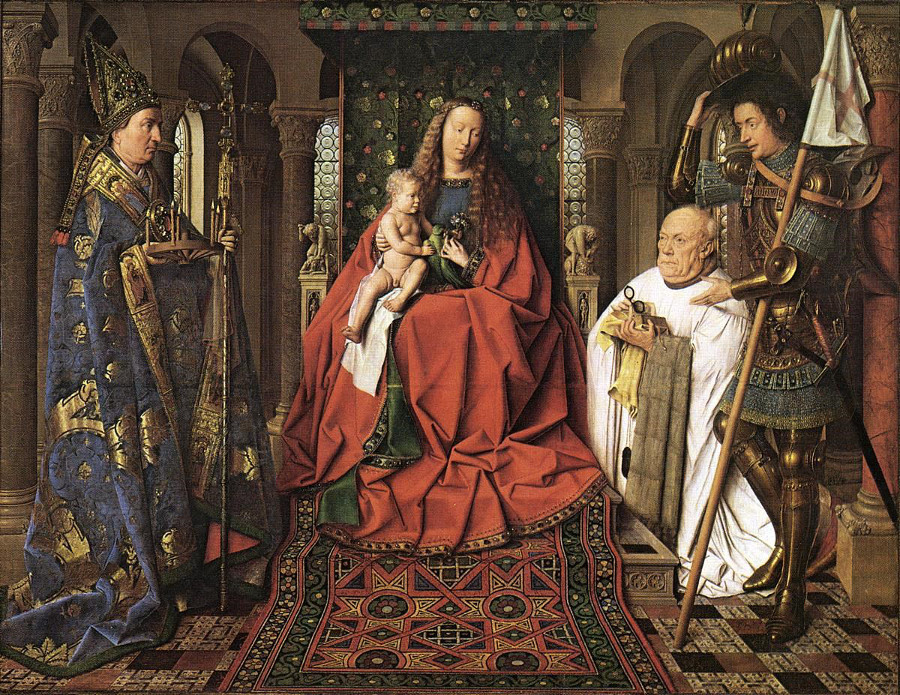
11. Jan van Eyck. Madonna. (At Bruges.)
This picture was painted
in 1436. You will admire the tenderness of expression in the Madonna, no
less than the characterisation of this figure (the Canon, Georg van der
Pole). It reveals a wonderful observation of Nature and a strong sense of
character, with all the primitiveness of the period — needless
to say. The next picture was painted by Jan van Eyck in Spain, whither
he had been summoned.
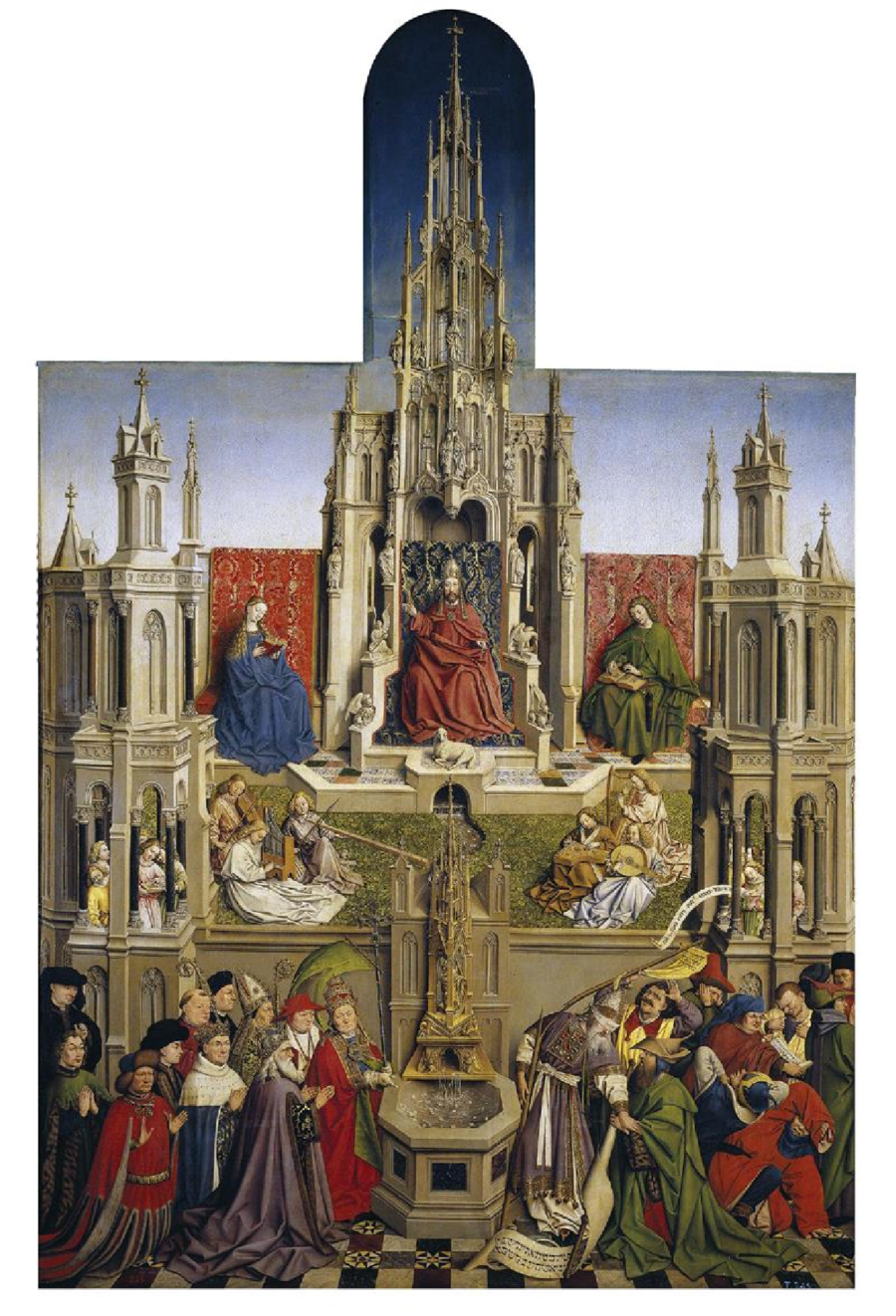
12. Jan van Eyck. The Waters of Life. (Prado. Madrid.)
Observe the Gothic
architecture in the background. To represent the Waters of Life, the Well
of Life, in connection with the Sacrifice of the Lamb, was natural to the
ideas of that time. Once more, as in the former picture, you have the
motif of God the Father with Mary and St. John.
Here, however, it is
transferred more into the spirit of the Southern Art — not
unnaturally, as the picture was painted in Spain.
In the former picture we
had the same theme treated with more of the Northern character.
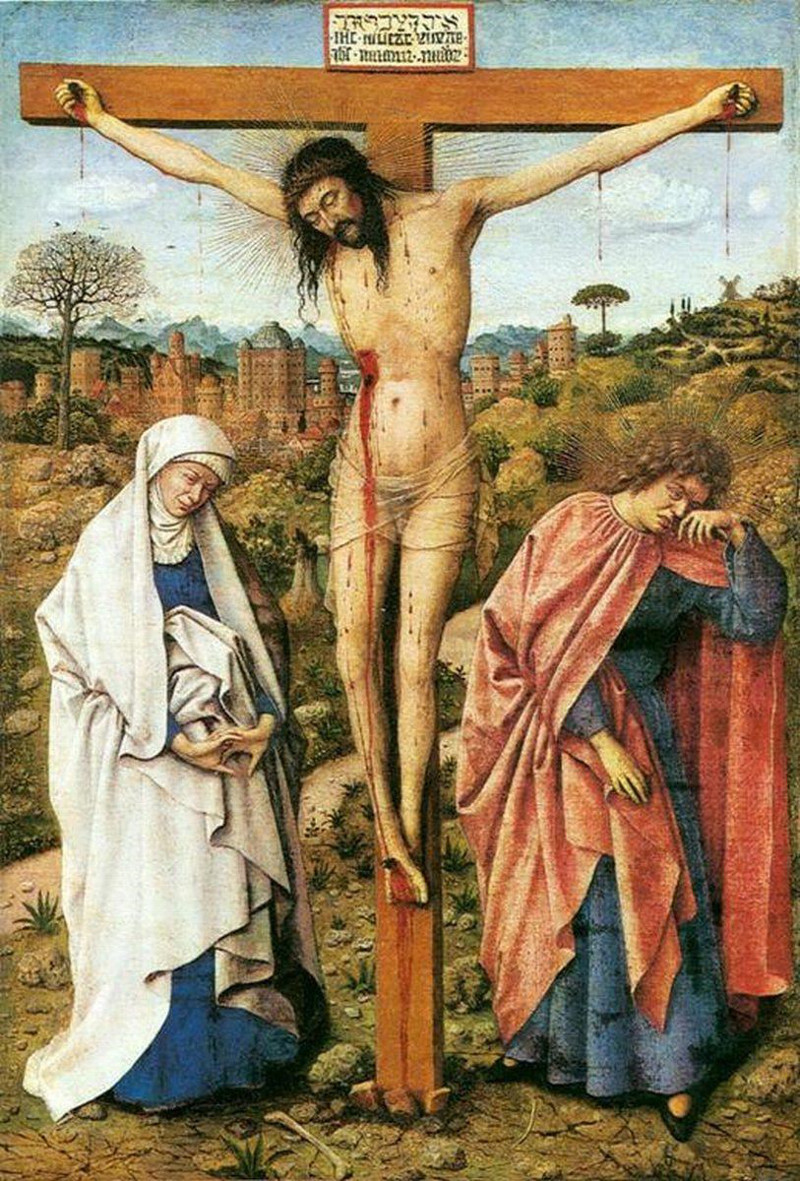
13. Jan van Eyck. The Crucifixion. (Berlin.)
Notice how the characteristic
qualities come to expression in this picture. The human element far
outweighs the Biblical tradition. Only the subject, the occasion, we
might say, is taken from that quarter. See with what deep human sympathy
the Biblical story is re-awakened, as it were. Here it is not merely
the prevalent idea that it is meet to represent in pictures what the
Bible tells. The whole event is felt again and re-experienced in the
highest degree. It is scarcely conceivable — (pointing to the
figures of Mary and St. John) — that a Southern artist would have
placed this line, and this, side by side. Here, however, the painter's
chief concern is not with the composition, but to give an impression
of real inwardness — to realise the inner experience. And then
we must say that the effect of this line, and this line, together, is
most wonderful, characterising as it does the different moods of the
soul.
We now give two examples
of secular subjects by the same artist.

14. Jan van Eyck. The Betrothal. (National Gallery.
London.)
This picture shows very
clearly how great was the artist's power of characterisation and
expression. Our last picture by Van Eyck shows the attempt to get still
further in the way of portraiture;
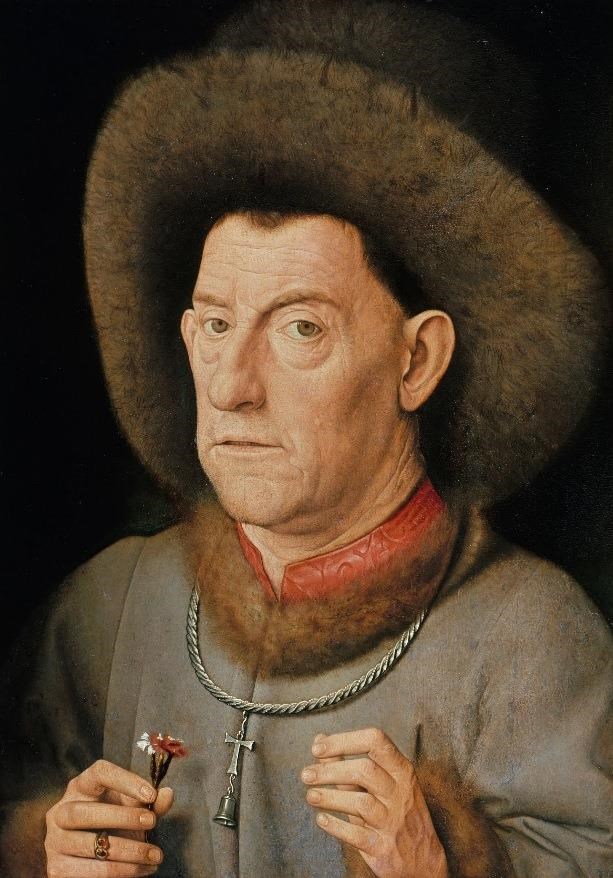
15. Jan van Eyck. The Man with the Carnation. (Berlin.)
Here you will see with great
distinctness, the artist does not care at all to conceive what a man
should be like; he does not work out of any such impulse, but as he
sees the human being — whatever presents itself to his vision
— this he reproduces.
We now come to a
contemporary artist who outlived Van Eyck by a few years — the
Master of Flémalle, as he is called.
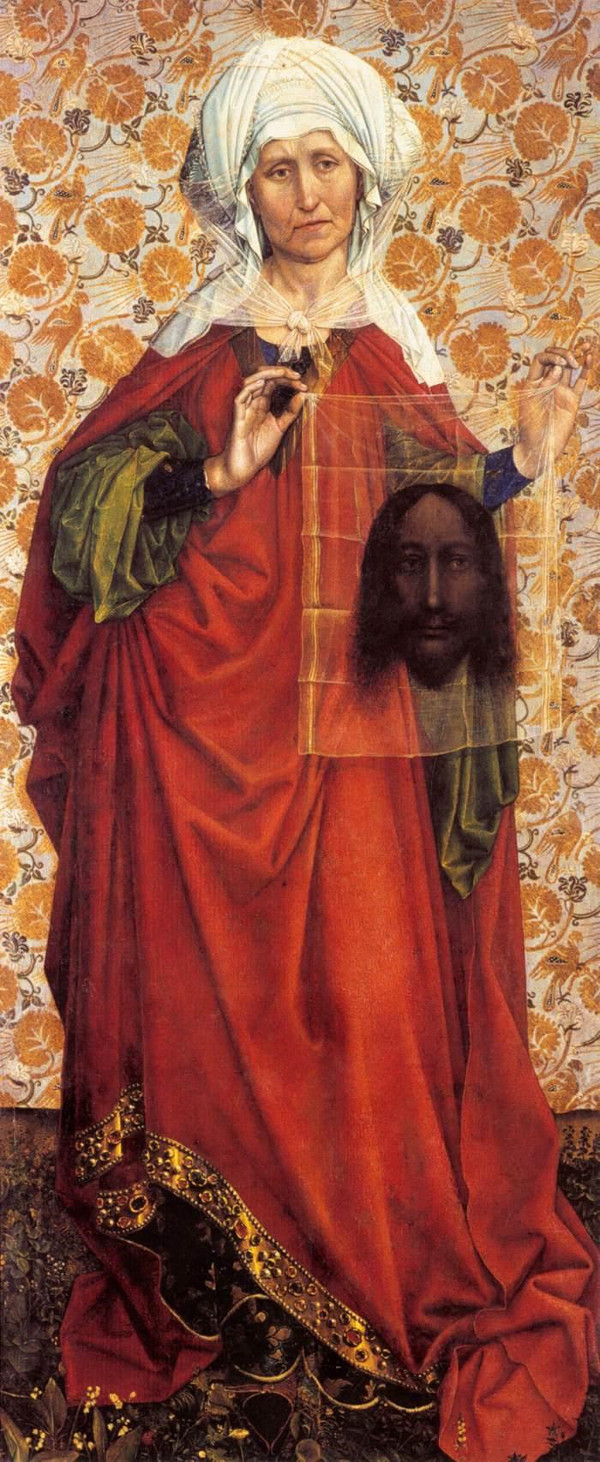
16. Master of Flémalle. St. Veronica. (Frankfort.)
In him we recognise a seeker
inspired by somewhat the same impulse as the Van Eycks, yet influenced far
more from France. He recognise these influences in the “line.”
There is a kind of echo of artistic tradition. In Van Eyck's work we
feel that everything is born out of an elemental inner need. Here, on
the other hand, there is already an underlying opinion — this
thing or that ought to be represented in such or such a way. Though
they are not by any means predominant in his work, still we can see
the Master of Flémalle accepts the principles of certain aesthetic
traditions. In the former artist you will not easily find, for example,
this peculiar position of the hand, nor this peculiar treatment of facial
expression. These elements in the picture are undoubtedly to some extent
determined by certain influences from France. An atmosphere of elegant
grace is poured out over these figures, which you will not find to this
extent in the figures of Van Eyck.
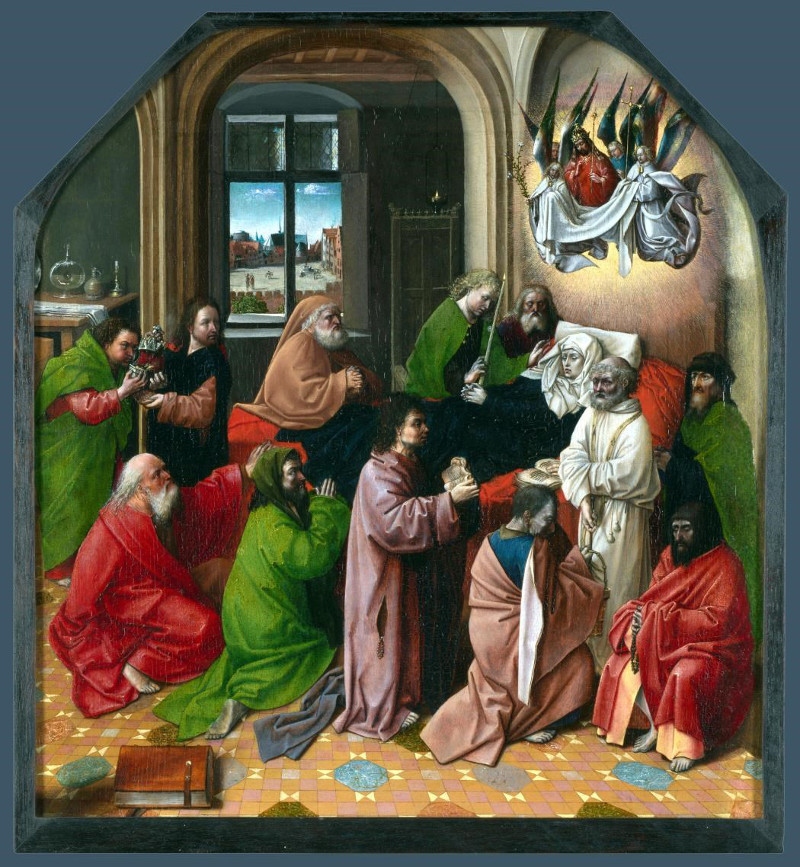
17. Master of Flémalle. Death of the Virgin.
(London.)
Characteristically —
this picture shows the Christian legend transplanted into the artist's
present time. These pictures were painted about the thirties of the
15th century.
We now come to Van der
Weyden, who — like the former artist, received certain influences
from France. Still, he contains all those elements which mark him out
clearly as a follower of the Van Eycks.

18. Rogier van der Weyden. Descent from the Cross. (Berlin.)
Already in this picture
you will see a characteristic difference. There is an essentially dramatic
life in this, whereas we might say Van Eyck is purely ethical. Van Eyck
places his figures quietly side by side; they influence one another,
but there is no one all-pervading movement. Here, however, in Van der
Hayden's work, there is a certain drama in the working together of the
figures. It is not merely ethical.

19. Rogier van der Weyden. Descent from the Cross. (Prado.
Madrid.)
The same subject, treated
once more by the same artist. And now a picture taken from the Christian
legends.

20. Rogier van der Weyden. St. Luke painting the Madonna.
(Munich.)
Here you see the Evangelist
St. Luke, who, as the legend has it, was a painter, painting Mary and
the Child.
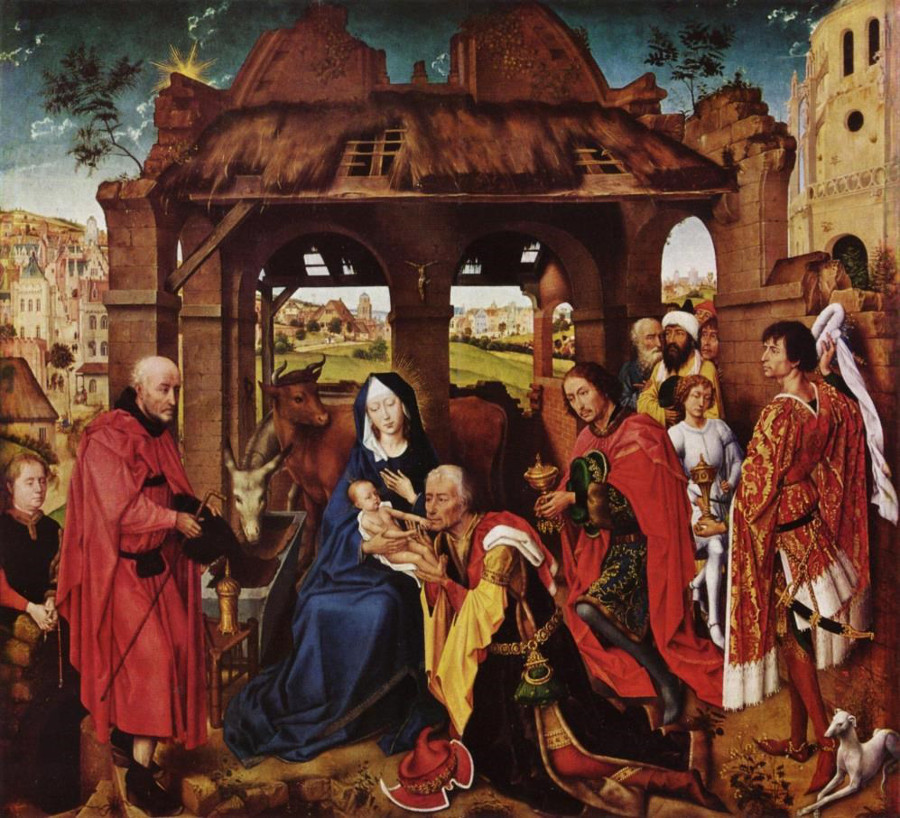
21. Rogier van der Weyden. Adoration by the Three Wise
Men. (Alte Pinakothek. Munich.)
One of these is King Philip
of Burgundy; this one, who is just taking off his hat, is Charles the
Bold. If only by this external feature, the whole scene is very much
transferred into the artist's immediate present. For the Kings who come
to worship the Child, he takes the figures of princes more or less of
his own time.
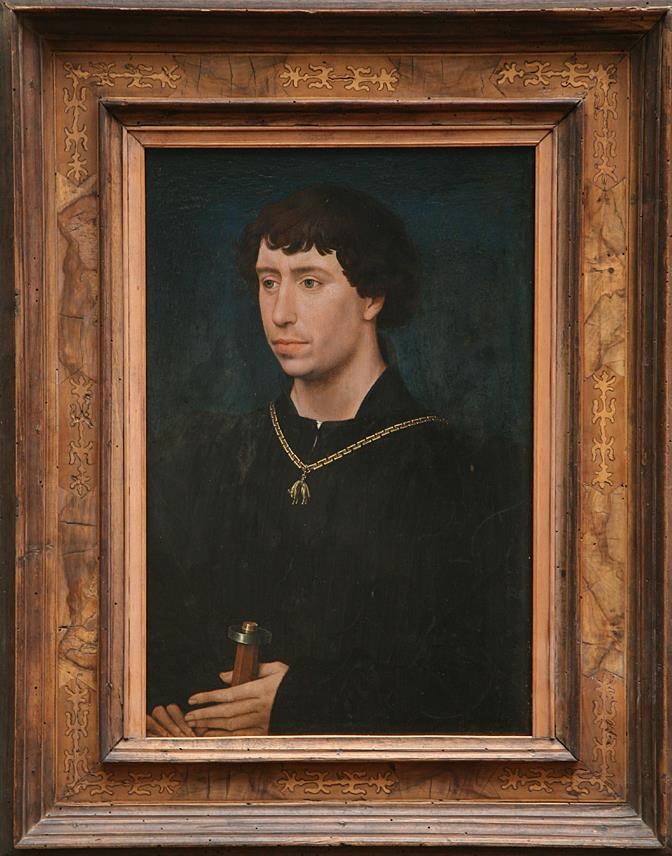
22. Rogier van der Weyden. Charles the Bold. (Berlin.)
Here, then, we have a portrait
by Van der Weyden. All these artists attained — a certain perfection
in the art of portraiture.
We now come to Petrus Christus:
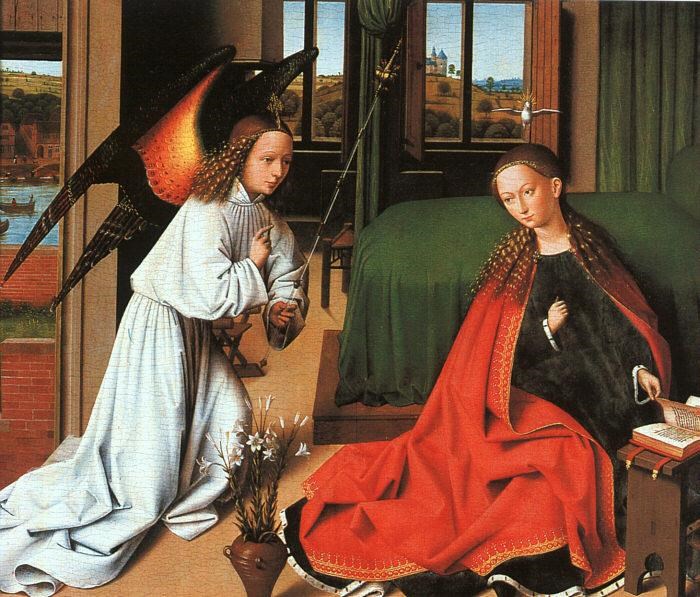
23. Petrus Christus. The Annunciation (wings of an Altar-piece) (Berlin.)
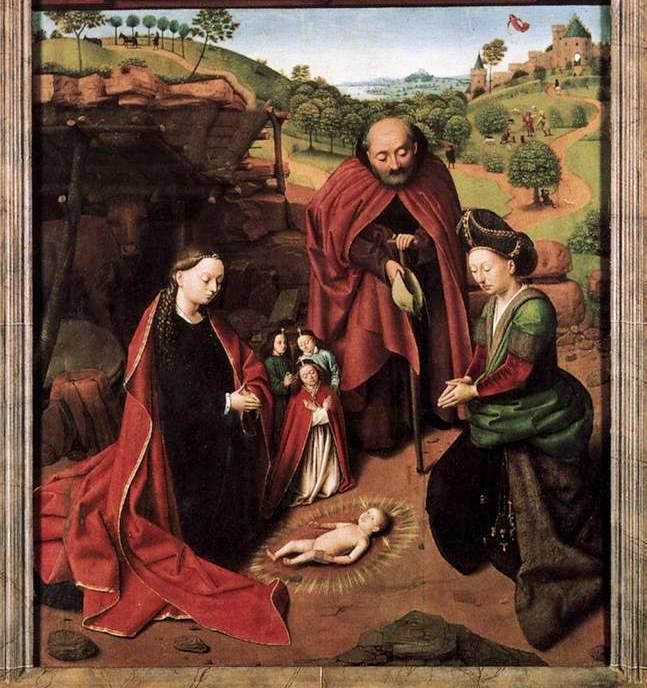
24. Petrus Christi. The Birth of Christ
The Angel and Mary (The
Annunciation) and the presentation of the Christ Child. Petrus Christus
works more or less equally along the lines of Van der Weyden on the
one hand, and the Van Eycks on the other. These pictures were painted
about 1452 — the middle of the 15th century.
In the following pictures
we come increasingly to the more Northerly Dutch element, where the
landscape is developed to greater and greater perfection. The next picture
is by Dieric Bouts the Younger. And now, a picture extraordinarily
characteristic of this stream in Art:

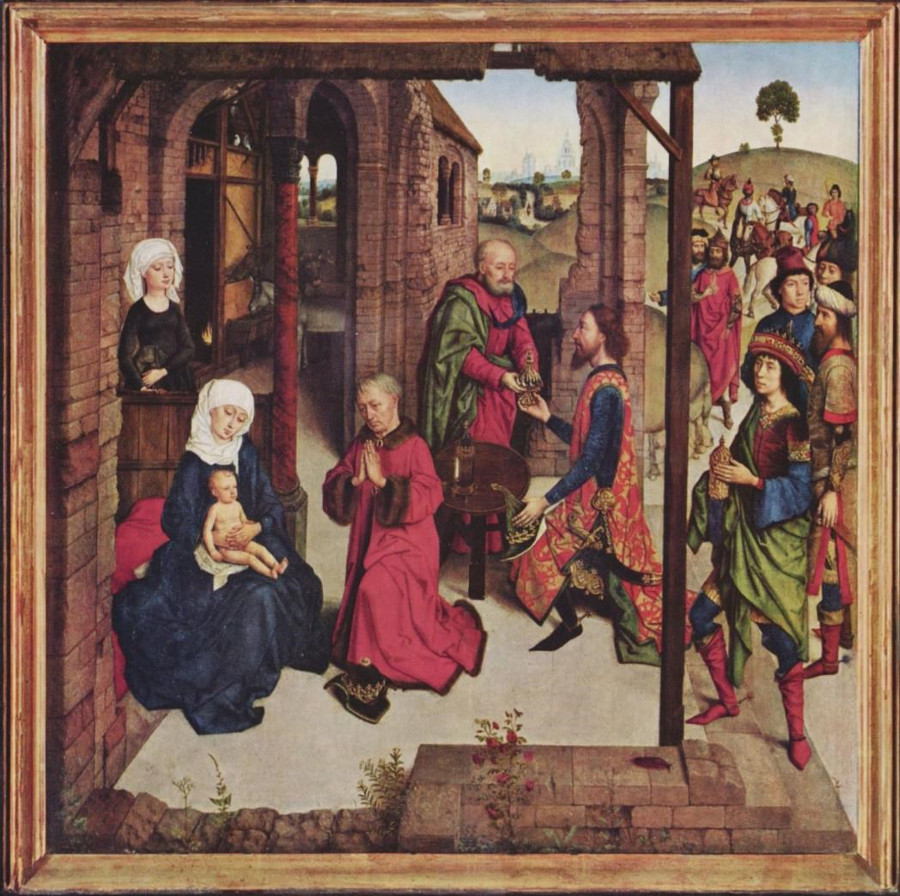
25. Dieric Bouts. Adoration by the Three Wise Men. (Alte
Pinakothek. Munich.)


26. John the Baptist and Christopher
On one side is the Baptist;
on the other side the Christophorus — the Christ-Bearer. Truly,
there comes to expression here the full and immediate human inwardness,
and with it the landscape that belongs to it. In Dieric Bouts you will
especially notice this art — to place the human being fittingly
within the landscape of open Nature.
The realistic representation
of things is working its way through more and more. Man as an artist
becomes more and more able to find, in the direct reproduction of Nature,
what he has been striving for along this path.


27. Hugo van der Goes. Portinari Altarpiece, c. 1475.
(Uffizi. Florence.)
Truly, Realism has here
reached a high degree of perfection. The same subject again:

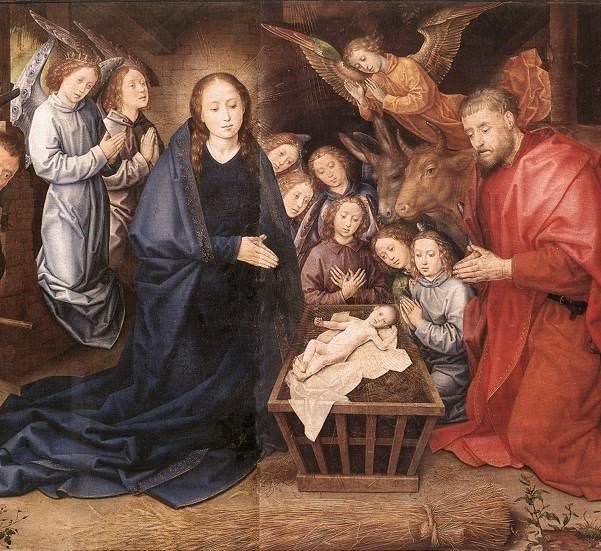
28. Hugo van der Goes. Adoration by the Shepards, 1480
(Berlin.)

29. Hugo van der Goes. St. Anthony and St. Matthew.
Below are the Donors of
the picture. By the same artist:
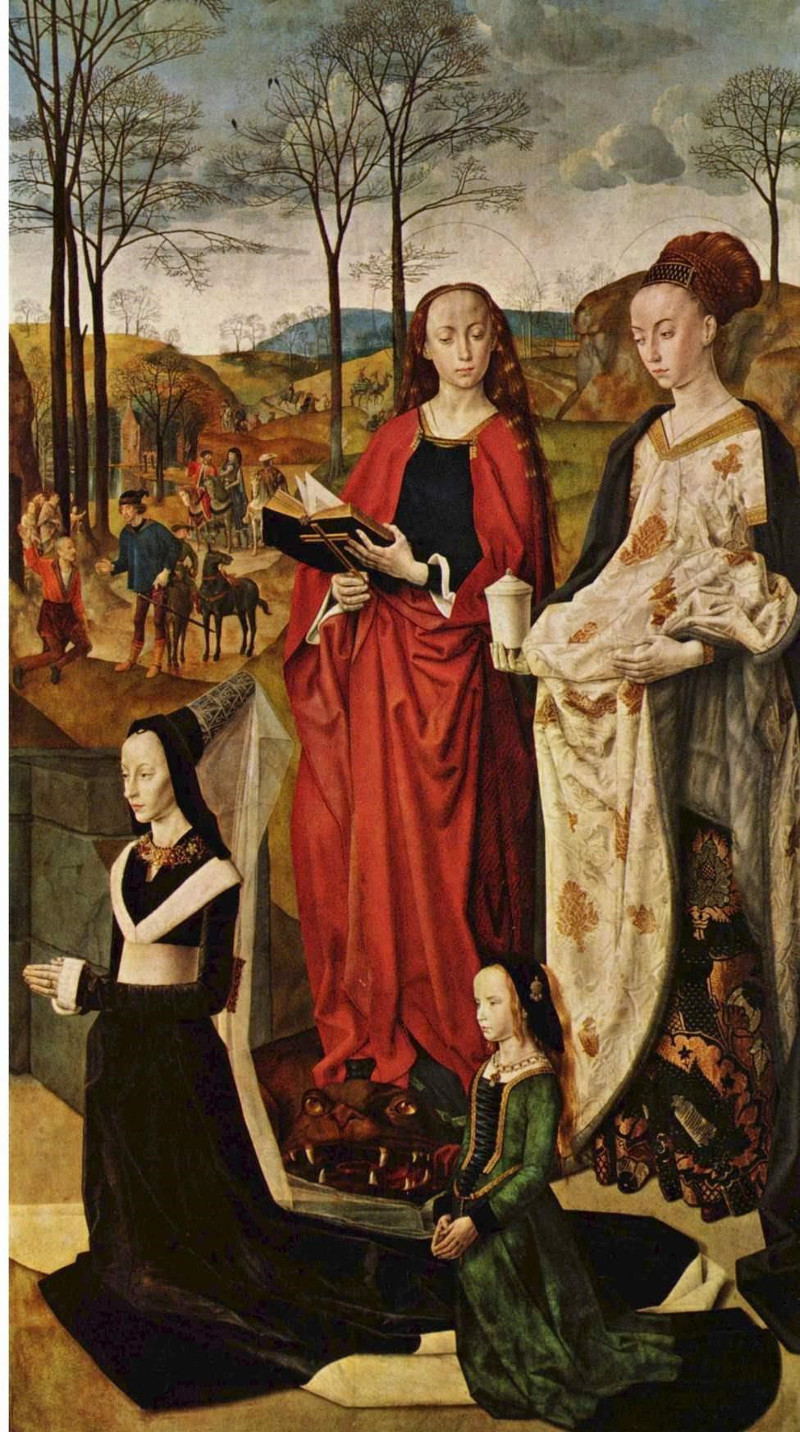
30. St. Margaret and St. Mary Magdalene. (Ste. Maria
Novalis. Florence.)

31. Hugo van der Goes. The Death of Mary. (Academy.
Bruges.)

32. Hugo van der Goes. Adam and Eve. The Fall. (Vienna.)
The Art of that time —
as I have said on previous occasions relating to Meister Bertram —
did not picture a mere snake, but tried to portray the Luciferic
element.

33. Meister Bertram. The Fall (Hamburg.)
That the snake itself —
the existing physical snake — should have been the Tempter, is
an invention of the most modern naturalistic materialism.
We now come to the artist
who, educated in the School of Van der Weyden, represents, in a certain
sense, its continuation. He was known in the School as Der deutsche
Hans. I refer to Hans Memling.
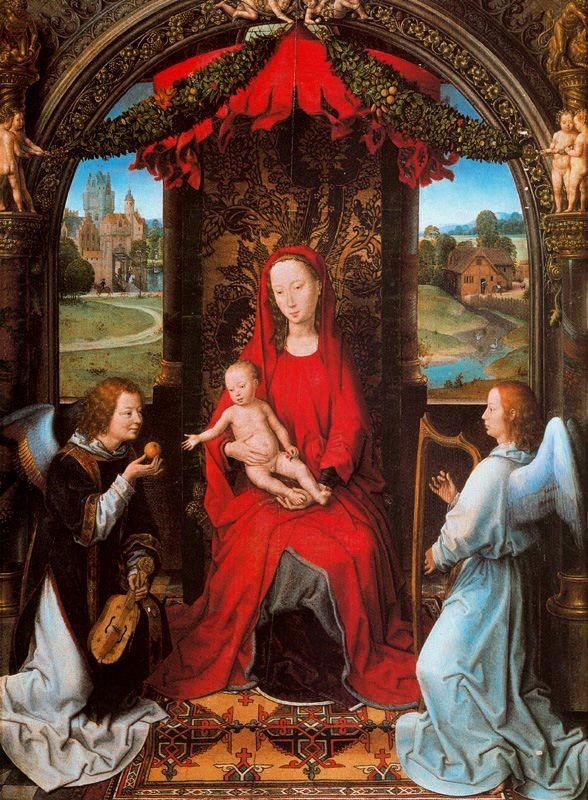
34. Hans Memling, Madonna Enthroned. (Uffizi. Florence.)
This artist was born at
Mainz. We shall, if possible, in the near future, show some examples
of Upper German paintings, which have their own characteristic peculiarities.
Its tendencies are quite evidently present in this picture; but for
the rest, Memling had absorbed all that was then living in the Art of
the Netherlands, including the influence that came over from France.
The next picture is also by Hans Memling.
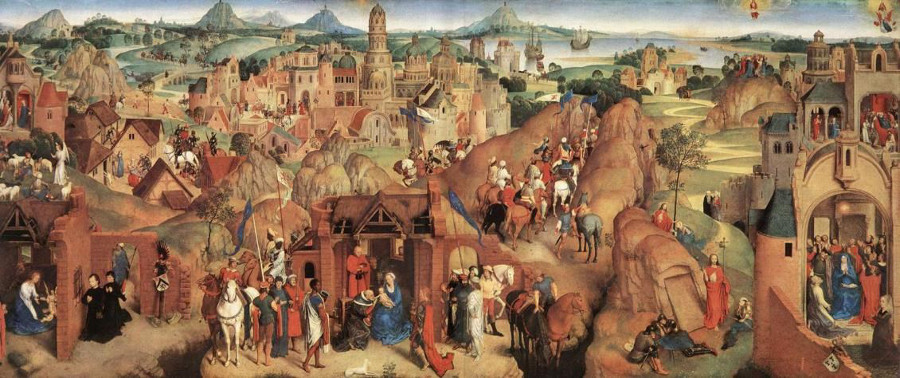

35. Hans Memling. The Seven Joys of Mary. (Munich.)
— a motif which was
also familiar to those times. The various events connected with the
life of Mary are here portrayed. Unfortunately it is too small in this
reproduction to recognise the details very clearly.

36. Memling. The Last Judgment. (Marienkirche. Danzig.)
A characteristic picture
by Memling. With real genius, in his own way, he brings to expression
his conception of the Last Judgment. There is a certain angular quality
about it, and yet the whole event is permeated with humanity, with inward
feeling. The picture is note at Danzig. A powerful trader stole the
picture — but, being a pious man also, he afterwards bequeathed
it to a church in Danzig.
He will also acquaint
ourselves with Memling's portraits. You will see that all this School
achieves a greatness of its own in representing the human
individuality.

37. Memling. Portrait of a Man. (Berlin.)
The expression of the
qualities of the soul in this face is, indeed, remarkable. This is a
well-known picture at the Hague.

38. Memling. Portrait. (The Hague.)
We come now to the later
artists who no longer show quite the same freedom and simplicity, but
a certain contortion and inner complexity. David, for instance, was
born in 1400; he came from Holland. Hitherto, we may say, we have had
before us the pre-Reformation period in Art; the artist we shall now
show brings us already very near the Reformation.
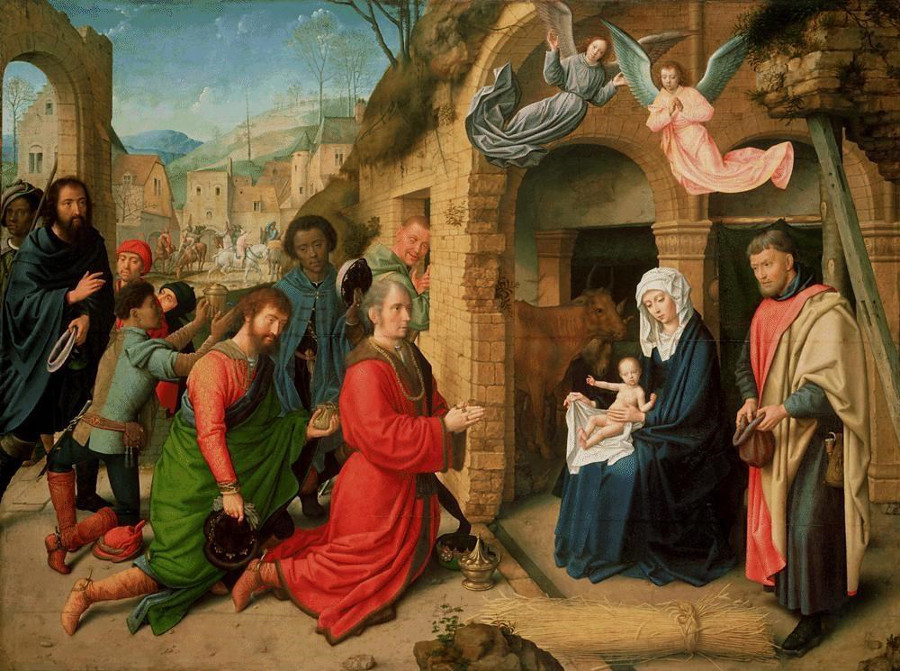
39. Gerard David. Adoration of the Magi. (Munich.)
Here you will recognise
how strongly the Southern influence is already working in the element
of composition.

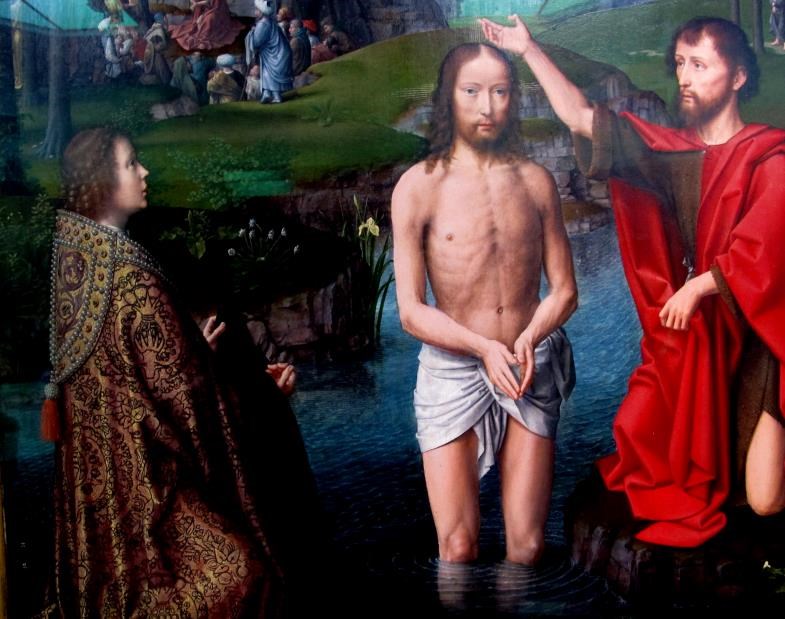
40. Gerard David. Baptism of Christ. (Bruges.)

41. Gerard David. Madonna and Christ, with Angels. (Rouen.)
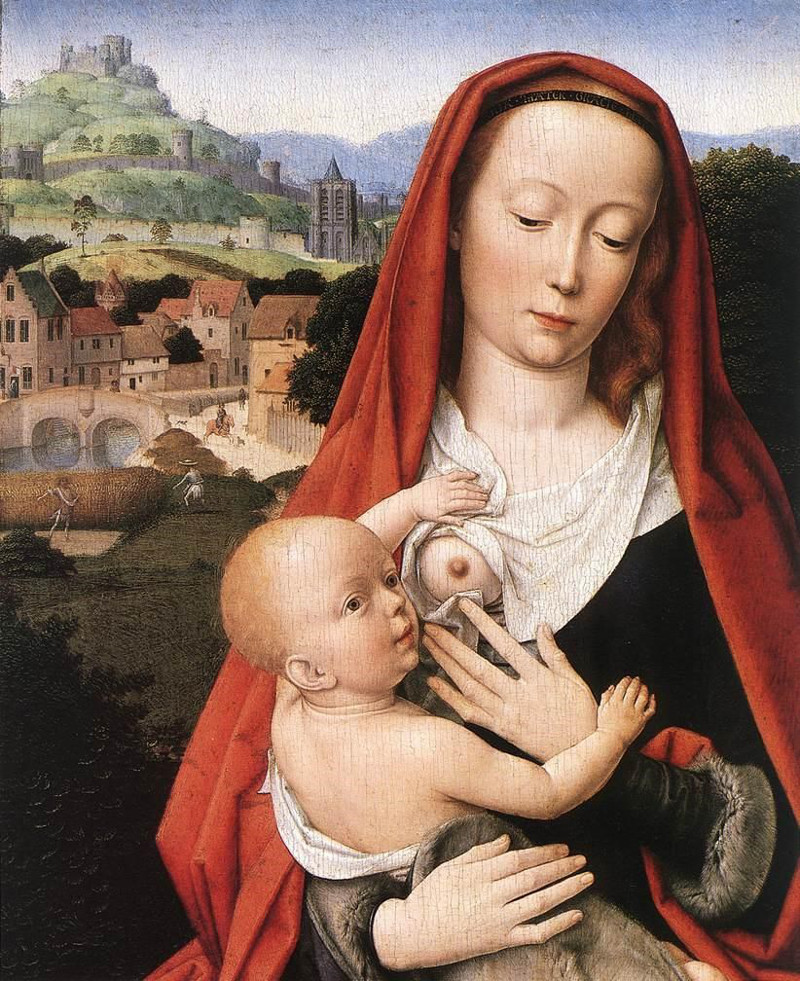
42. Gerard David. Mary and Child
The next is by an artist
who was in a sense only a kind of imitation of David. We now come to
Geertgen, who, though he dies at the early age of twenty-eight, does,
indeed, bear within him all the peculiar characteristics of this epoch.
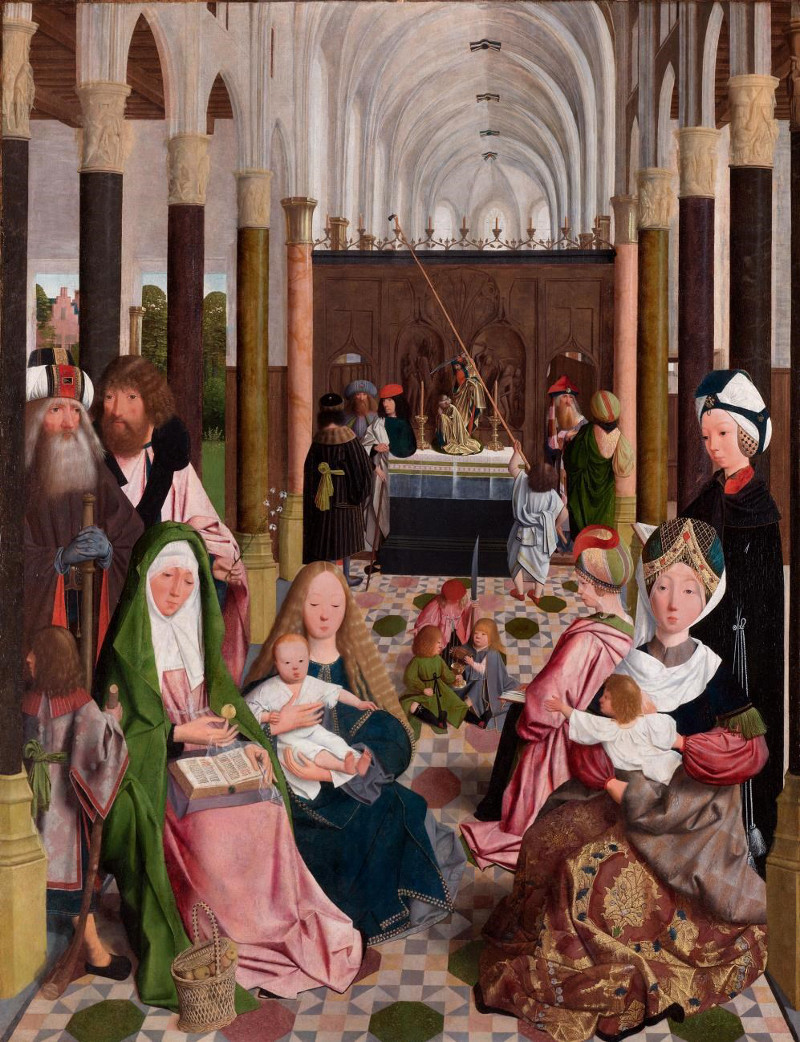
43. Geertgen. Holy Family. (Amsterdam.)

44. Geertgen. The Holy Night. (Berlin.)
As we go forward into the
16th century, other elements mingle more and more with what was
characteristic of the Van Eyck period. We come now to Hieronymus Bosch.

45. Hieronymus Bosch. Descent from the Cross.
In his work we find a strong
element of composition. Also we have no longer the mere naturalistic
observation. His work is permeated with a fanciful, fantastic feeling
— so much so, that he becomes the painter of all manner of grotesque
and “spooky” subjects.
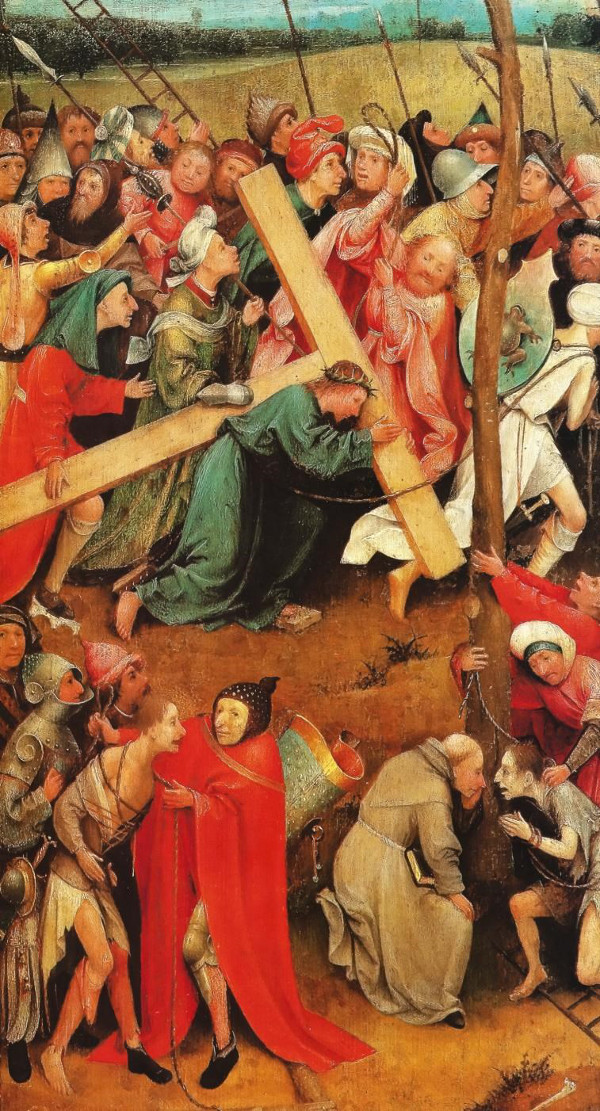
46. Hieronymus Bosch. Christ carrying the Cross.

47. Hieronymus Bosch. Hell. (Prado. Madrid.)
The fantastic element is
mingled with all that he had learned in this direction.
Now we come to Quentin Matsys,
in whom the element of composition is already strongly paramount. Indeed,
this is already in the 16th century.
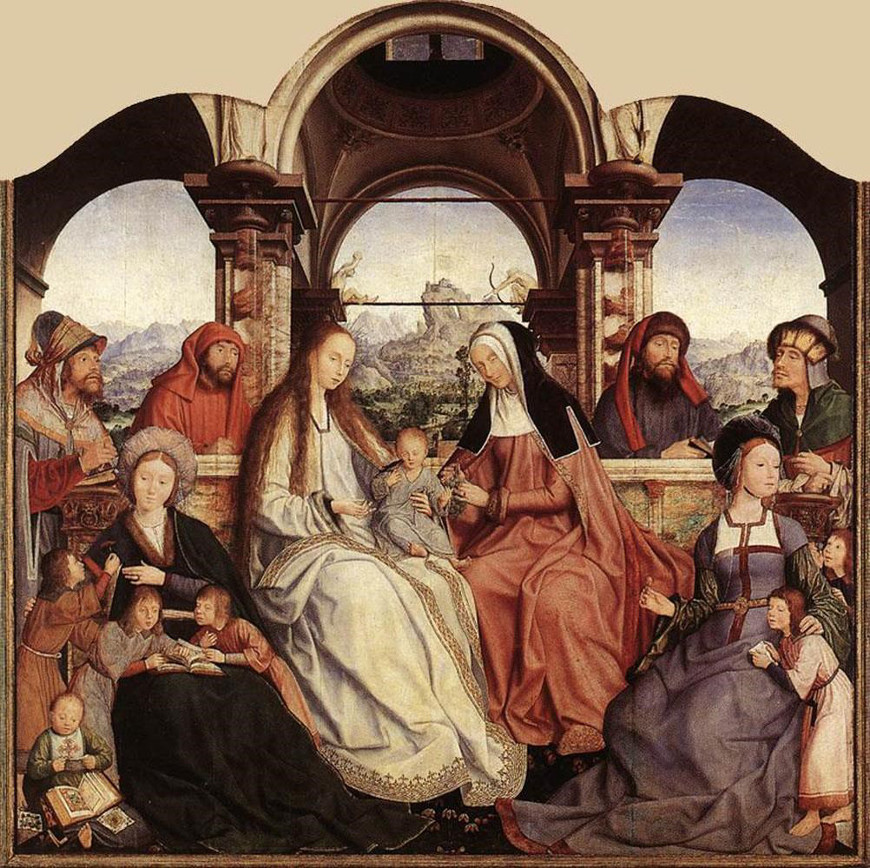
48. Quentin Matsys. Holy Family, 1509. (Brussels.)
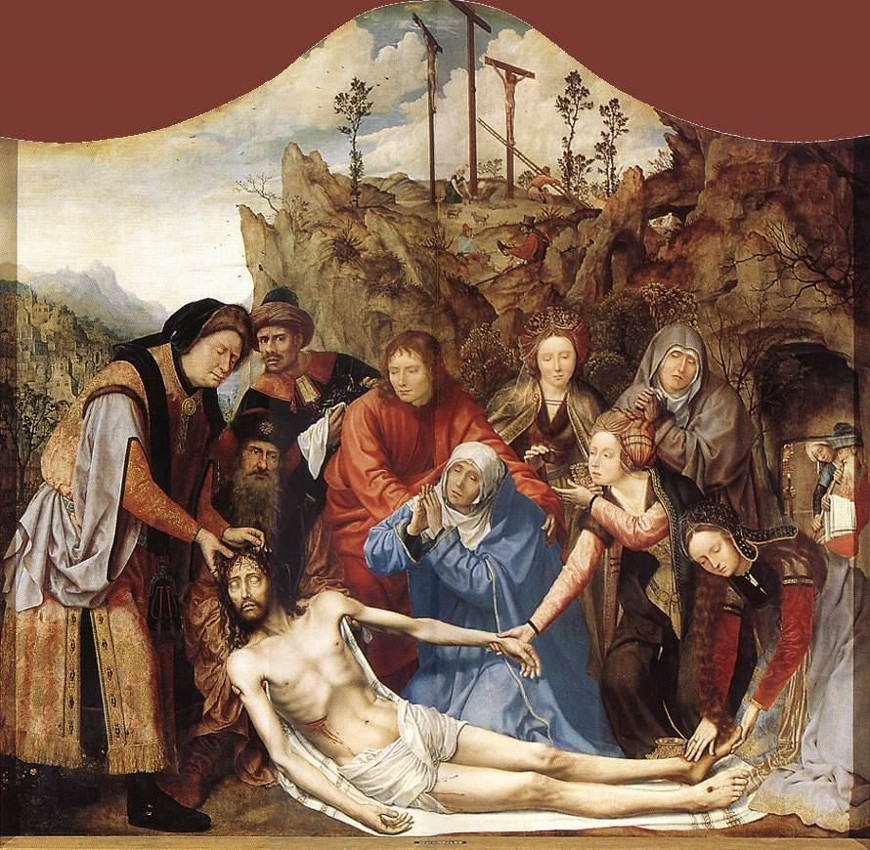
49. Quentin Matsys. Mourning for Christ. (Antwerp.)
Here you see quite deliberate
composition. In the next picture we shall see how this feeling for
composition combines with that for individual characterisation even where
there is less intensity of form, or movement, in the group.
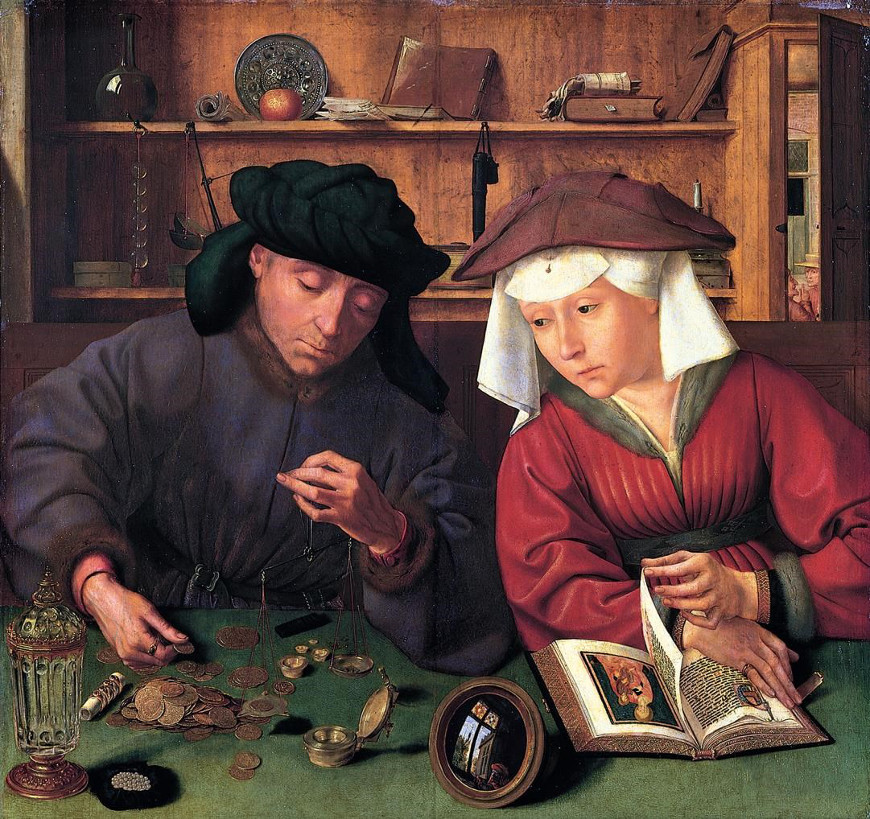
50. Quentin Matsys. The Money-Changer and His Wife.
(Louvre. Paris.)
We now come to an artist who
reveals the characteristics of the period especially in his
landscape-painting — Joachim Patinir. It was at this time and from
these regions that landscape-painting first developed and found its way
into the full artistic life. Only from this time onward was it really
discovered for the life of Art.
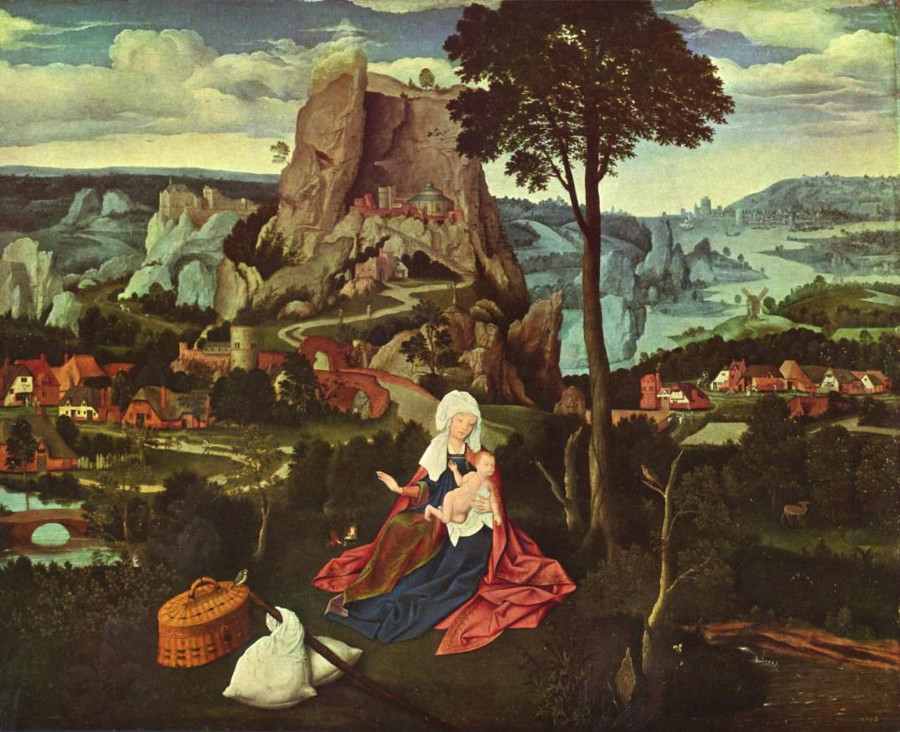
51. Patinir. The Flight into Egypt. (Madrid.)
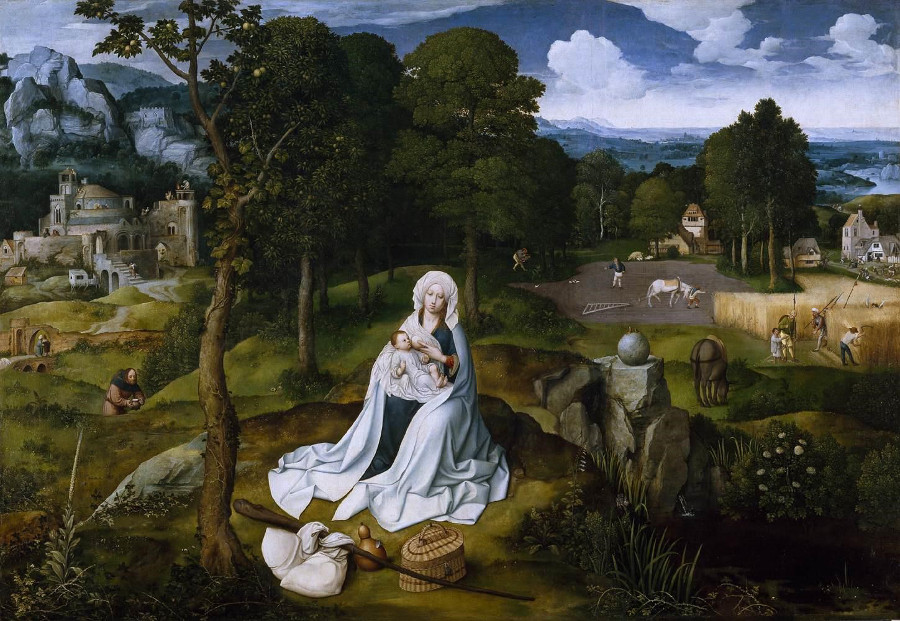
52. Patinir. The Flight into Egypt. (Berlin.)

53. Patinir. The Baptism of Christ. (Vienna.)
I beg you to look at this
especially, from the point of view of landscape-painting. Such landscape
treatment could naturally only originate in the age of attempted
naturalism; only then does landscape begin to have a real meaning
for Art.

54. Patinir. Temptation of St. Anthony. (Prado. Madrid.)
The next is a painter quite
definitely of the 16th century. I spoke just now of the
“Burgher” element. He carries it still further, even into the
sphere of the peasantry. His works are born of the elemental simplicity
of the people. Nevertheless, all manner of other influences enter into
them — Italian influences, for example. Thus he strangely unites
his elemental Dutch simplicity with a very marked Renaissance feeling.
I refer to Pieter Brueghel — born in 1525.

55. Brueghel. The Pious Man and the Devil. (Naples.)
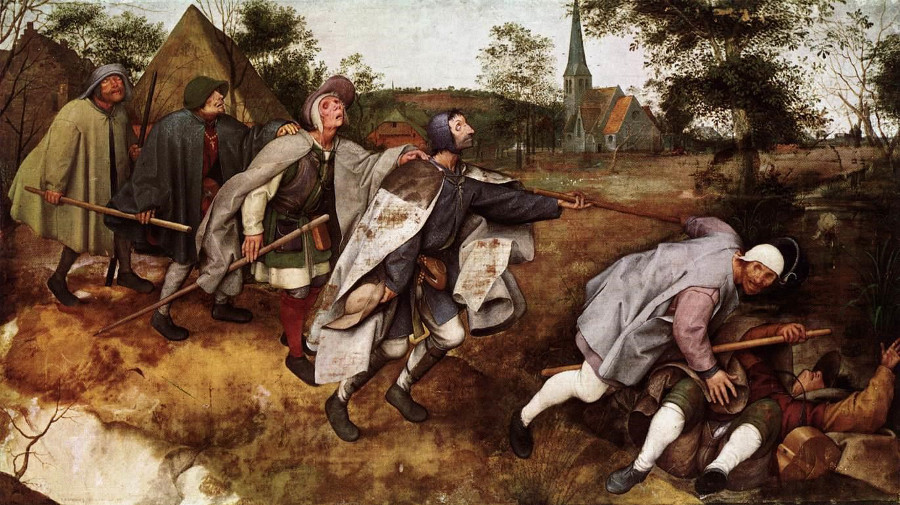
56. Brueghel. The Blind Leading the Blind. (Paris. Louvre.)

57. Brueghel. The Fall of the Angels. (Brussels.)

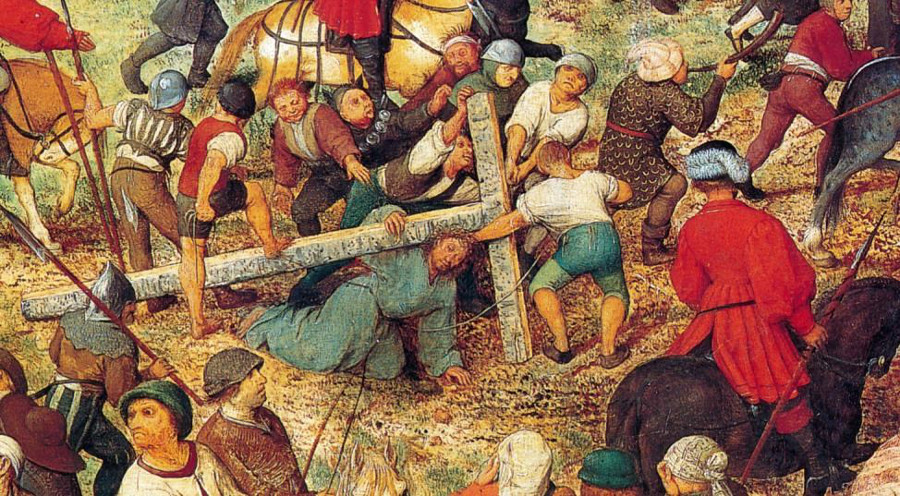
58. Brueghel. The Way to Calvary. (Vienna.)
And another Biblical subject
by the same painter.

59. Pieter Brueghel. The Adoration of the Magi. (London.)
With that, we will finish
for today.
|